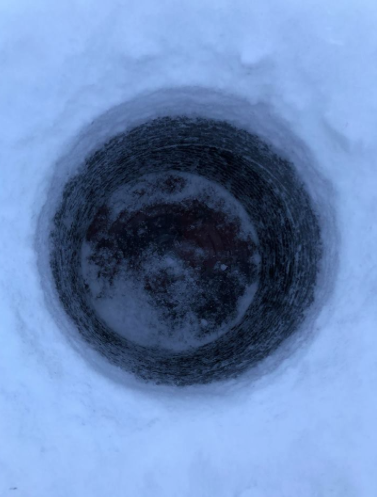|
Last week Martin and I had to go out and re-set the fishnets. The first time the fishnet was set it was in a location where the water was too shallow. We are only in the beginning stages of winter and the ice is going to get a lot thicker in the coming weeks. The water at our original location was only 8 feet deep. Ideally, the net should be set at a location that is about 25 feet deep. You want the net to sit at the bottom of the lake with plenty of room between the top of the net and the bottom of the ice. Keeping the net away from the bottom of the ice helps the process of checking because if the net is too close to the ice it will freeze solid. Jenn and Martin went and pulled the net out of the first location and it had 25 fish in it!! They were able to go deliver those around town. Re-setting the net was a lot of fun. We borrowed a jigger from a local elder and set out for the middle of the lake. On the way Martin cut down two spruce trees. The branches are used to insulate the holes and the trunk is used to hold the string of the net out of the water. I find setting and checking nets to be quite fascinating. A hole is drilled into the ice and the jigger is inserted and attached to the bottom of the ice. I sat at the end that the jigger was inserted and slowly pulled on the blue rope. With each tug on the rope the jigger moved further along the bottom of the ice. The net is 24 feet long. Once it the jigger stopped moving we had the task of finding where the jigger ended up and then drilling another hole. This process was harder than i expected. We measured 24 feet in the direction that we sent the jigger and then laid on the ice and listened for its clicking. The echoes of the ice can really throw you off. Once we located the jigger, we drilled a second hole and threaded the net under the ice. My first guess was about 10 feet off. Next we attached either end of the net to the tree trucks and covered the holes with spruce bows. The net will stay in the water until the ice thaws in the spring. You cover the spruce bows with snow to keep them from blowing away in the crazy arctic winds. We have checked the nets 4 times since setting them last week. Each time that it has been checked there has been 15-20 fish in it (and once there was 40). The dead fish are stored away for dog food and the live fish are distributed to the community.
Today Martin took two of my students with him to check the nets. They loved their field trip and were each able to bring 3 fish home to their families! The skills and experience that the students will gain from this net is so valuable!
1 Comment
|
Adventures in the Arctic:
I invite you to journey with me as I embark on an adventure of a lifetime! Archives
June 2019
Categories |














 RSS Feed
RSS Feed
